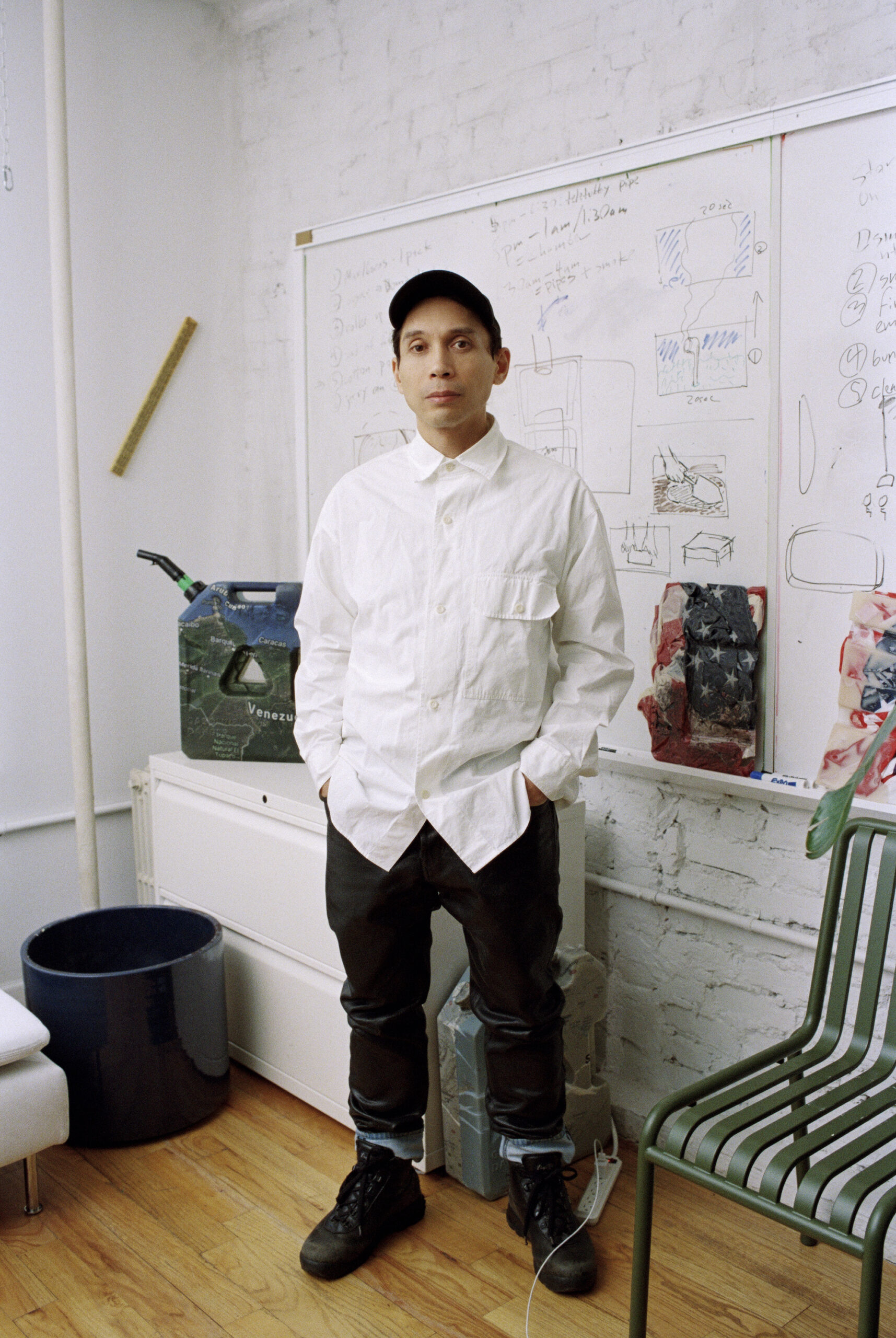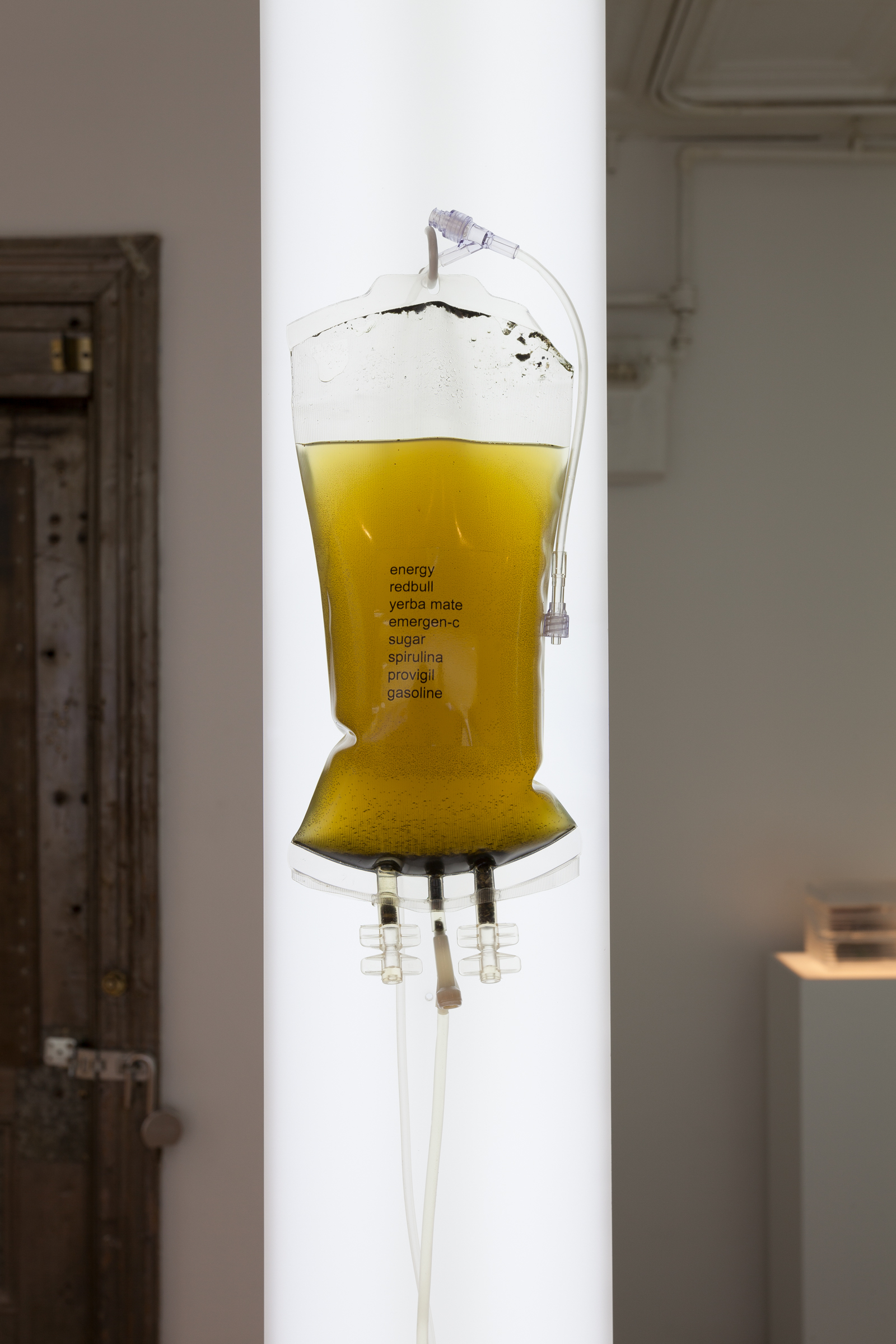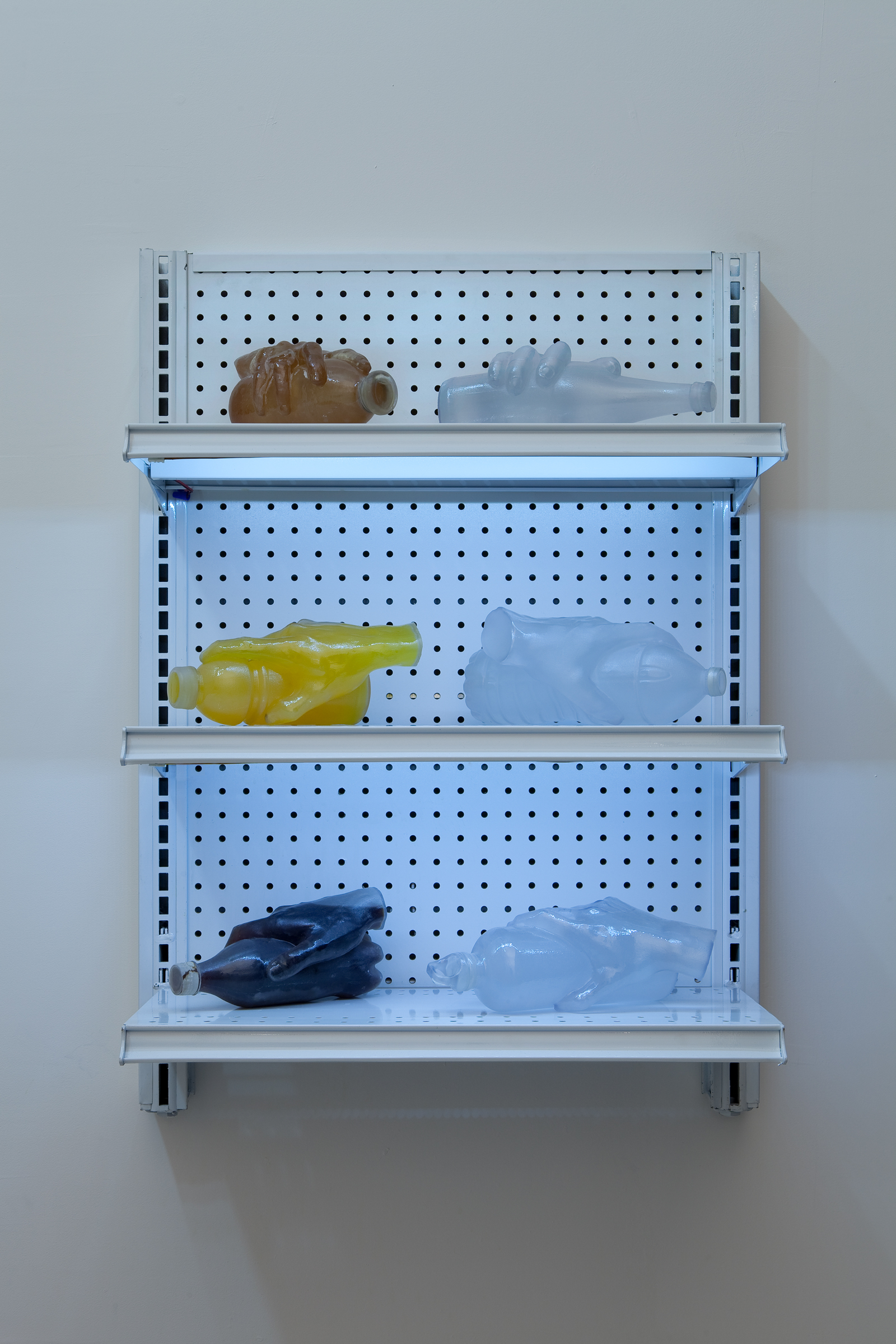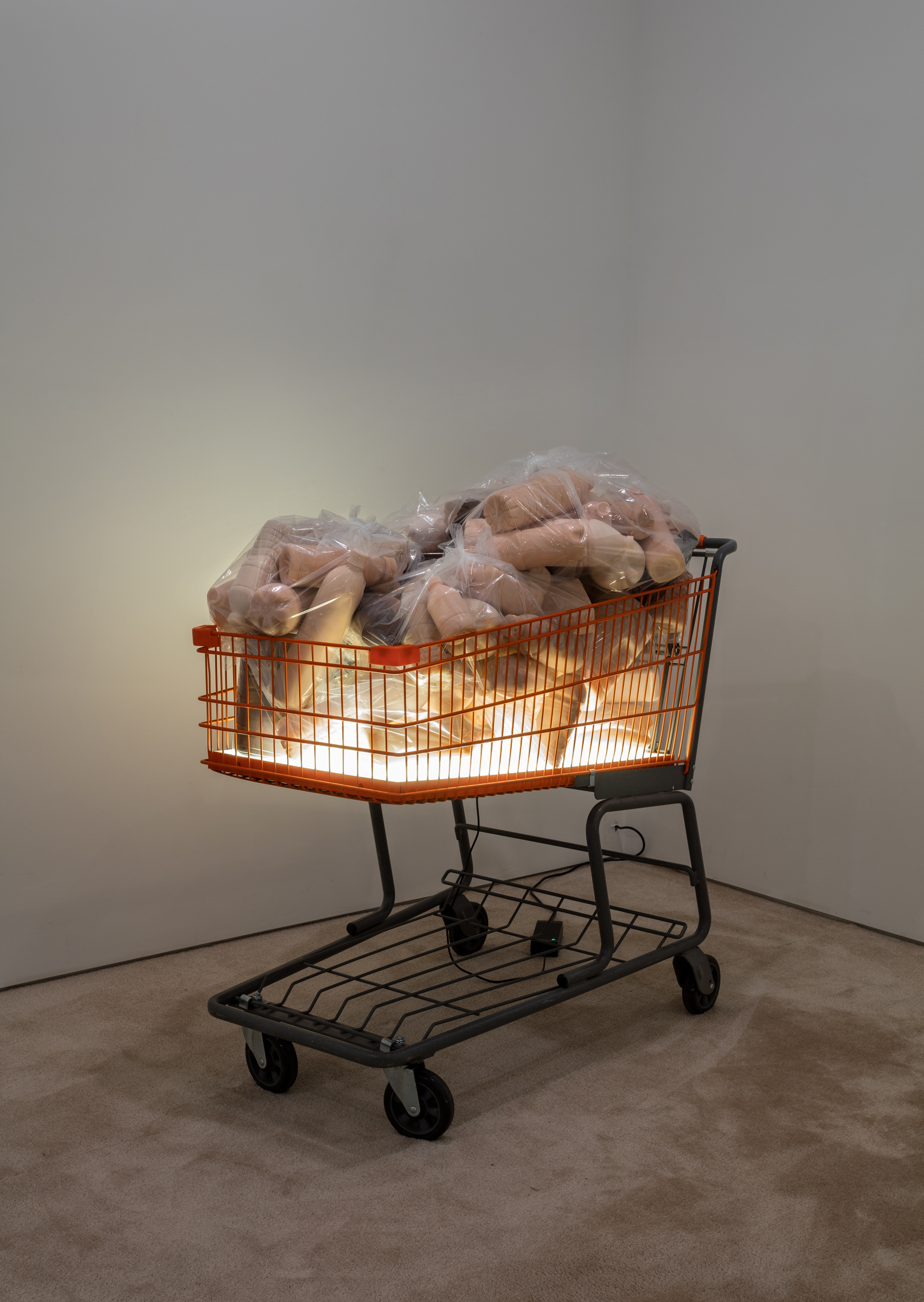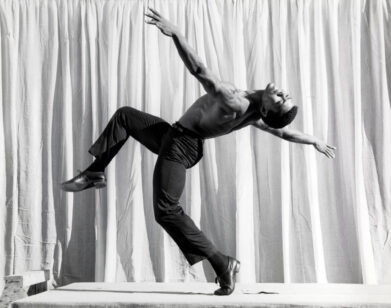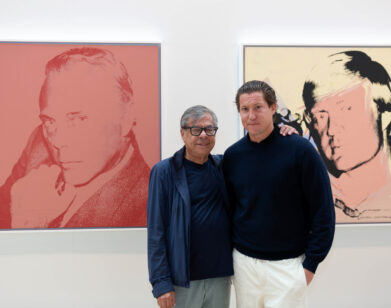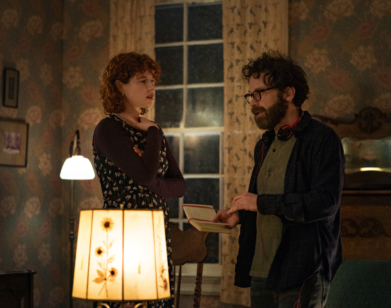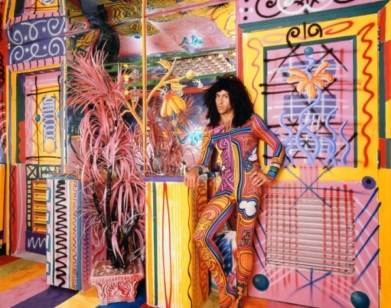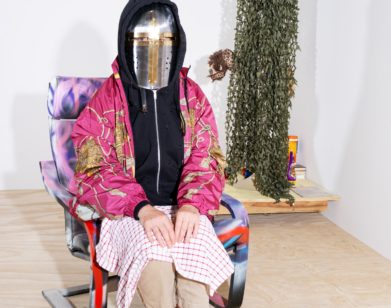ART
Enter Josh Kline’s Dystopian World
Since 2011, Josh Kline has been shocking the art world with dystopian works that tackle the chaos of our technologically charged and environmentally catastrophic era. While preparing for a survey of his sculptures, installations, and videos at the Whitney Museum of American Art this spring, the artist called up his friend and occasional collaborator, musician Galcher Lustwerk, to discuss net-art–era trend forecasting, writing, and why having too much access to the past is inhibiting us from imagining a better future.
———
GALCHER LUSTWERK: Can I start, Josh?
JOSH KLINE: Yeah, go for it.
LUSTWERK: Congratulations on your Whitney show, and thank you for letting me do the soundtrack for the Adaptation film portion. It was really cool to work on. I was wondering: You had a really specific production schedule and style for the film. You used 16-millimeter. What kind of effects were you going for?
KLINE: I think I OD’ed on HD video and CGI animation in the 2010s, and I needed to take a break from it. Film felt like the right direction, because it was so different from that HD video I was working in, that felt so locked into this 2012 moment in video art. Also, film has this inherent nostalgia that comes with it. I wanted to create a vision of the future that wasn’t just our present, in the future, but something else. In a way, I wanted the characters in the film to be looking back at our present from the perspective of their future. So the film is about a kind of nostalgia, and film made sense for that.
LUSTWERK: Cool. I think I tapped into that vibe when I was trying to include the saxophone as a representation of New York jazz, and how distant that is culturally, and yet it still permeates the public’s idea of music and the city.
KLINE: I like the sax. I also had this kind of Blade Runner Vangelis feeling, while at the same time being something totally different. But it brings in a bunch of interesting nostalgia.
LUSTWERK: Is Adaptation the only film you have in the show?
KLINE: The only one shot in 16-millimeter. Everything else is video.
LUSTWERK: It’s a cool contrast. Digital is cleaner and more clinical, whereas 16-millimeter is more expressive and poetic.
KLINE: That’s where I wanted to go. Although with the new sculptures that I’m making, I’m trying to find a new poetic language within digital media. I mean, there’s actual poetry going onto the sculptures, poetry writing, which is interesting to talk to you about, considering your music. When did you start writing lyrics?
LUSTWERK: It was a combination of moving to New York and working in branding and doing PDFs and pitches, where you’re coming up with weird names and logos. At the same time, I was exposed to what all my art-world friends were doing. And with electronic music, it seemed like there was much more weirdness that could happen. There wasn’t as much of a club scene in the early 2010s, so I didn’t have any template to work off. I took inspiration from advertising and branding and stuff that I was working on at my day job.
KLINE: So your rap lyrics were coming directly from your advertising work?
LUSTWERK: No, but it honed my ability to pare down a message. In middle school all the way to college, I was being indie or real backpack-rappy, or very emo and expressionistic, with lyrics. But with electronic music you want a more pared-down message and a more palatable, loopable lexicon to work with.
KLINE: There’s power in repetition.
LUSTWERK: So the poems you’re working on for these sculptures, how are they meant to be read?
KLINE: It’s similar to what you were saying. I had been writing the press releases for all my shows for years. They’re like artworks in their own right. Also, they were the longest things that I could write at the time because I had a full-time job and writing’s always been hard for me. We shot Adaptation in 2019. For those who haven’t seen it, it’s this film set in a future flooded Manhattan where this crew of relief workers emerges out of the sea, basically around a flooded Rockefeller Center. They board this boat in the construction-worker equivalent of wet suits, and they take advantage of being in this boat in Manhattan in high summer, and watch the sun set between the buildings. I was working on editing it and doing post-production, all the visual and special effects, during lockdown and quarantine, which is when we started talking. The more I worked on the film, the more I realized it was about lockdown.
LUSTWERK: I can see that.
KLINE: The experience that we were having in 2020 and 2021 was a dry run or a taste of what’s going to happen with the climate crisis this century, and all the disruption and upheaval and cancellation of what we think of as normal life. So I decided to re-record the audio, and just on a whim, I was like, “Maybe I’ll write some text, and have these actors record it.” Non-narrative text, basically more like the press releases that I was writing. But then it became poetry, and that ended up becoming the voiceover for the film read by the different actors. When I started working on these new sculptures for the show, which are essentially tents about migration and refugees and climate refugees and dislocation, I decided I’m going to put the poetry onto the sculptures. It’s literally printed on the fabric of these tents.
LUSTWERK: I like that because I feel like at the moment, text-based art is out of style. Or maybe it’s just that graphic tees with words on them are out of style. I’m ready for a comeback on that.
KLINE: I’m really into it. During the pandemic a lot of artists figured out how to make paintings. I wish I had done that, because it’s very lucrative. And my video work takes a lot. But, I went deep into a writing zone, both screenplays and, I developed a poetry practice, which wasn’t what I thought was going to happen. No regrets.
LUSTWERK: Instead of getting into AI or machine learning, you’re getting down and dirty with actual words that are coming out of your brain.
KLINE: Absolutely. It’s also something no one can take away. I had this moment during the pandemic where nothing was happening. There were barely any shows. Nobody was going to see anything. If there are no shows, no fundraising, and no budgets, you can still write. If you can’t afford paint or 3D printing, or film and camera, you can still write.
LUSTWERK: What are your ambitions for a future feature-length film?
KLINE: I’ve written a legit sci-fi story and I want to make it into a proper movie. It’s not an art film.
LUSTWERK: You want to distribute it the way most films get distributed versus being at a gallery?
KLINE: Yeah. Originally, it was going to be an art project, but the more I worked on the screenplay, the more I realized, “This is not nonlinear. It’s actually a linear narrative. I want to see it go into the world.” It’s The Matrix meets a World War II refugee story meets Kids meets Dancer in the Dark. It’s not anything that anybody’s seen before.
LUSTWERK: Very cool.
KLINE: I have to tell you, when we were talking back in the day, I didn’t realize that you were part of K-Hole. I figured it out after we finished the soundtrack and it blew my mind. I was into your music, but I was also a fan and admirer of what K-Hole was doing. There’s a lot of work I’ve done that involves advertising that’s in this Whitney show, and K-Hole as a collective was all about advertising. What are your feelings about advertising?
LUSTWERK: I haven’t really talked about this, because for a long time, I kept K-Hole and my music stuff completely separate. But around the time we released our report on normcore, there was a lot of misunderstanding and miscommunication where I felt like the early effects of this information overload and ideas and images were becoming almost incomprehensible, or just magically associated with everything. So K-Hole was my way of feeling like I had some sense of control over images and text. I didn’t really do any of the writing, but I did all the copy editing to make sure it wasn’t too bookish. All the other members of K-Hole are incredible writers and well-read. I don’t have patience for that kind of stuff. So it was a cool exercise in editing an idea down and distilling it. Looking back, it was a cool multimedia exercise.
KLINE: Why was advertising so interesting in that moment? It seems less prominent as a subject in art right now.
LUSTWERK: Part of it has to do with the fact that the cycles are just getting quicker. And disillusionment is happening at a faster rate. I graduated college, went straight to a design agency, and was really drinking that Kool-Aid for a while. After a few years and a few projects with some evil corporations, you get disillusioned and realize, this is all really taking advantage of artistry. The advertising and branding sector just looks to art and counterculture for their ideas, and it feels more like a game than ever when all you have to do is figure out the algorithm.
KLINE: I do wonder if, because of AI and algorithms and other factors, we are living in a society where it’s impossible for human beings to have an overview. A society has been created that is only maybe comprehensible by machines. It’s something new and disturbing.
LUSTWERK: But you’re bucking that trend with wanting to do a feature film. People’s attention spans are just different now. I feel that way with music—I’m making my tracks shorter.
KLINE: Do you think a lot about nostalgia in the music that you make?
LUSTWERK: I think about it, but not in a theoretical way. If I feel nostalgic, I’ll literally be like, “Oh man, that reminds me of the first time I listened to Goldie in high school.” It’s more of an autobiographical thing for me. Or it’s a vibe. But with music, I’m trying to create a new feeling. If that feeling is augmented by feelings of nostalgia, I want that to still feel authentic and not just referential. Not just throwing a breakbeat on there because I want it to sound ’90s. That’s not really how I work.
KLINE: I’ve been thinking a lot about newness. I’m questioning when newness is an important objective, and what is actually possible now. We’re in a time where it would make a lot of sense for there to be new aesthetics, because so many of the forms in media that we make our art in are rooted in this really fucked-up past. You think about contemporary art and a lot of the forms that people cling to, they’re basically all invented by white men and women. Even in the ’60s and ’70s, all the artists people prayed to were white. That’s the canon. Maybe we need new aesthetics to go with a new society if America is not going to just be a white society.
LUSTWERK: I often think that TikTok is offering a new aesthetic, simply because it’s made by people who have a different sense of time. This is what I’m worried about with music. Kids will grow up with TikTok never having listened to full songs. Their appetite for music will be completely different, almost to a point where they just wouldn’t listen to a song in the first place. So what changes in music? It could eventually evolve into musique concrète, but grindcore musique concrète where it’s 20-second songs.
KLINE: This is the peril of AI and algorithms. But maybe the reaction against it will create space for newness. I think about the ’90s when you had no idea what was going on in a city two hours away, and the kind of freedom that created. Just thinking you knew, and then reacting, and not having access to the complete archive of all human culture in the last hundred years. There’s freedom in that.
LUSTWERK: I feel like music is getting more niche. Or maybe I’m just getting older. Who knows? Maybe, going forward, it comes down to making sure everyone has the tools, but can understand how to use them to the best of their ability.
KLINE: Yeah, responsible use of the tools. That’s a good point for us to end on.
LUSTWERK: Great talking to you.

